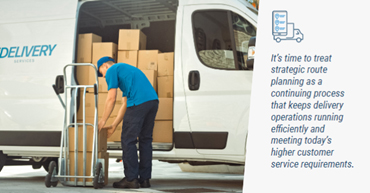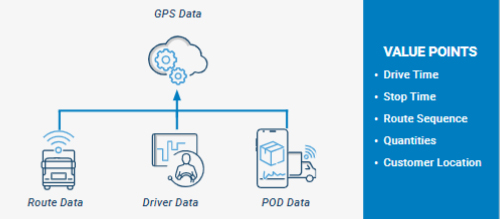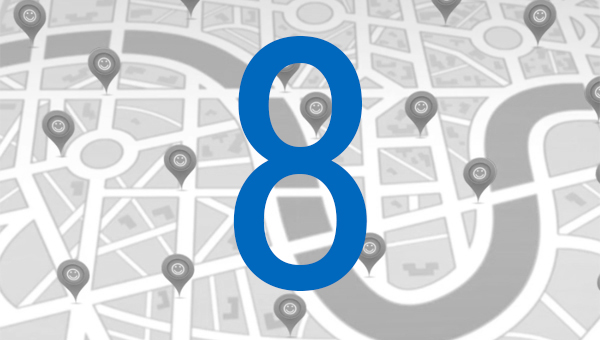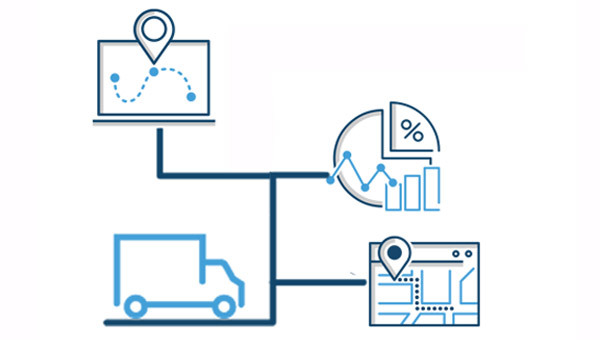Five Reasons for investing in strategic route planning for your deliveries.
Why Now is the Time to invest in Strategic Route planning for master, fixed or static routes
Despite the value of dynamic daily routing, many distribution-oriented companies cannot take advantage of it because of their customers’ delivery window, driver or commercial restrictions. To optimise their delivery operations, these companies engage in strategic route design on an infrequent basis or when some large event occurs.. The “multi-year review” is too long a period and companies are at risk of reduced profit in between reviews, as shifting customer bases and service policies are making existing master or static routes inefficient with negative impacts on their customer service. Technologies also evolve to make the strategic routing process easier and more agile. It’s time to treat strategic route planning as a continual process that keeps delivery operations running efficiently and meets customer service requirements.
Five Reasons for Looking into a Strategic Route Planning for your Delivery Network
If your company has experienced any of these five events, it should undergo a strategic route planning exercise now and introduce an ongoing strategic routing process:
- Your customer base has and continues to change
- Your customer service policies have and continue to change
- Your company went through a merger or acquisition
- Your company wants to know the potential impact of:
- Changes to the locations of Distribution centres and the capability after these changes
- Driver schedules and compensation plan changes
- New business models and delivery services
- New delivery asset options
- Potential acquisitions
- Significant volume swings during the year

Strategic Route Planning for Changing Times
It is likely that your company has at some time experienced some, or all, of the above events and recent worldwide events will have only increased their impact. It doesn’t require much change to make a master route plan less effective, so consider how out of balance your operations could be now. Strategic route planning needs to happen more frequently, to be part of the company’s strategy assessment process and impact tactical and operational routing decisions. For example, companies are changing their delivery strategies based upon peak and slow seasons, or even the weather to best serve customers and keep their costs in line.
So why don’t companies perform regular reroutes or have strategic routing processes? For most, strategic route planning is a painful and time-consuming exercise. The data is a mess, they lack the skills and the tools are too complicated or worse they try to do it on a spreadsheet and struggle to achieve better answers than the ones they currently have.
Two Key Technology Changes
There are two key technology changes that make strategic route planning easier to execute and more dynamic.
-
GPS-based Mobile Tracking
Tracking is critical, having accurate route data and knowing how the fleet is operating is important. Because of business changes dispatchers and drivers are probably not executing your old master routes as they were originally planned. They are working around them and you have no idea how far off your existing plans they actually are. GPS tracking will provide you with the accurate data required to understand how routes are actually being run, their stop times, etc. Much of the information you need to populate a strategic route planning solution will be provided from the GPS data.

-
Single Pass Route Optimisation Software
Limitations with traditional optimisation routing technology forced planners conducting a strategic route review to take the following 4-step approach:
- cut territories
- assign visit frequencies
- create routes
- review the results and make changes.
Repeating the process where necessary.
This process made a strategic route planning exercise more of an art than the science it should be. This is because territory, frequency, service day and route configuration are all interrelated. With single pass optimisation, all four are considered at the same time, helping to ensure better results, reducing the complexity and skills required and shortening the planning time.
In Closing
Strategic route planning can be a highly valuable process that will take cost out of the business, set the delivery network up to better serve customers and help to understand the implications of potential changes to the business before they are implemented. Rather than an approach that only uses strategic route planning occasionally, it needs to be utilised and deployed on a regular basis and as an integral part of the overall business strategy development and process improvement processes. The Descartes Route Optimisation Engine makes the whole process of strategic route planning easier, meaning that many scenarios can be trialled quickly, and the outcome easily understood.
Contact us if you are preparing or think your business needs to undergo a Strategic Route Planning Exercise to understand how we can help.
Click the "Get in Touch" button below
Or download our eBook - Strategic Route planning for Profitability
Further reading:
Eight ways to improve your productivity with delivery route planning software




